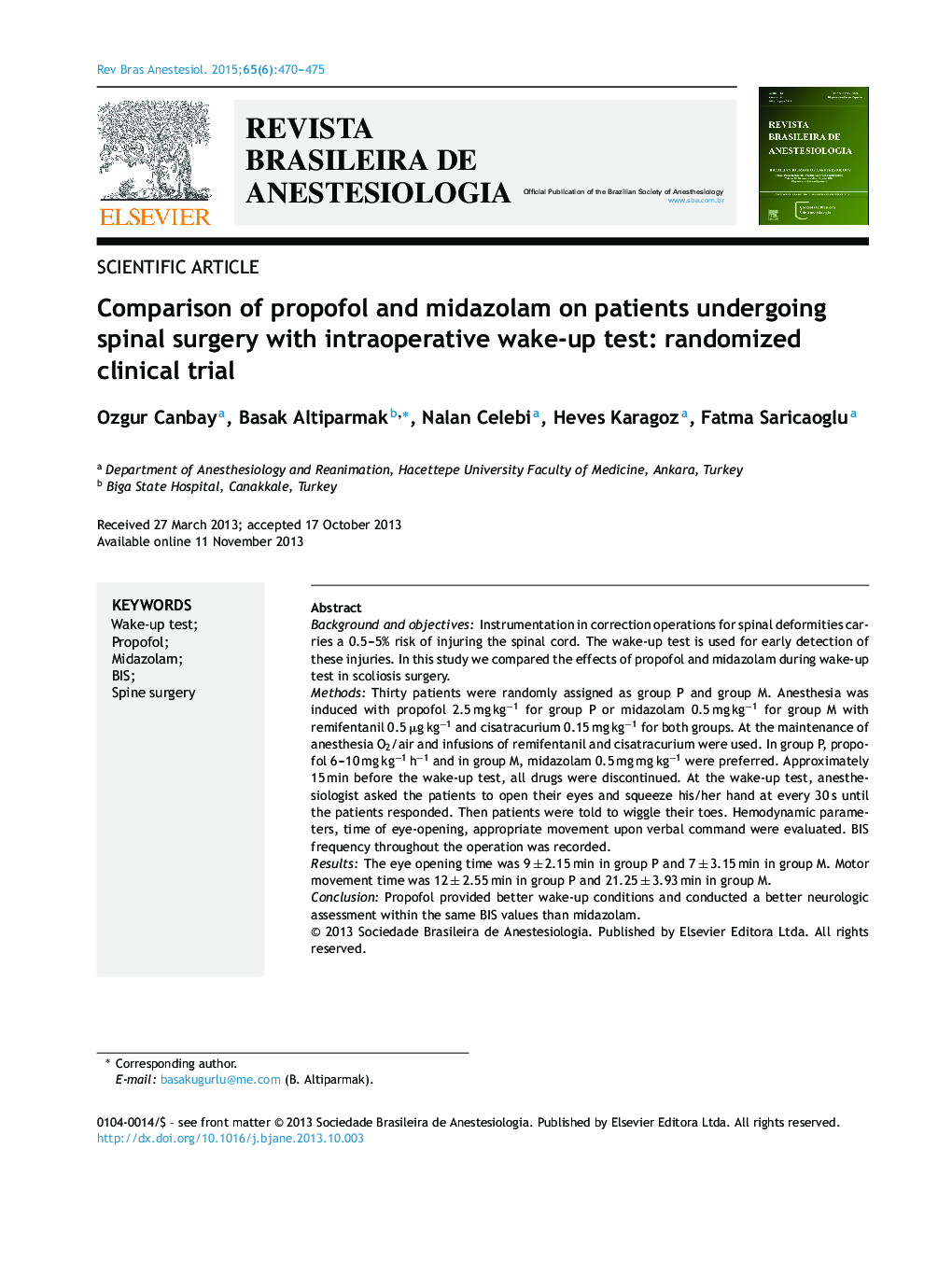| کد مقاله | کد نشریه | سال انتشار | مقاله انگلیسی | نسخه تمام متن |
|---|---|---|---|---|
| 2750225 | 1567301 | 2015 | 6 صفحه PDF | دانلود رایگان |
Background and objectivesInstrumentation in correction operations for spinal deformities carries a 0.5–5% risk of injuring the spinal cord. The wake-up test is used for early detection of these injuries. In this study we compared the effects of propofol and midazolam during wake-up test in scoliosis surgery.MethodsThirty patients were randomly assigned as group P and group M. Anesthesia was induced with propofol 2.5 mg kg−1 for group P or midazolam 0.5 mg kg−1 for group M with remifentanil 0.5 μg kg−1 and cisatracurium 0.15 mg kg−1 for both groups. At the maintenance of anesthesia O2/air and infusions of remifentanil and cisatracurium were used. In group P, propofol 6–10 mg kg−1 h−1 and in group M, midazolam 0.5 mg mg kg−1 were preferred. Approximately 15 min before the wake-up test, all drugs were discontinued. At the wake-up test, anesthesiologist asked the patients to open their eyes and squeeze his/her hand at every 30 s until the patients responded. Then patients were told to wiggle their toes. Hemodynamic parameters, time of eye-opening, appropriate movement upon verbal command were evaluated. BIS frequency throughout the operation was recorded.ResultsThe eye opening time was 9 ± 2.15 min in group P and 7 ± 3.15 min in group M. Motor movement time was 12 ± 2.55 min in group P and 21.25 ± 3.93 min in group M.ConclusionPropofol provided better wake-up conditions and conducted a better neurologic assessment within the same BIS values than midazolam.
ResumoJustificativa e objetivosA instrumentação em cirurgias de correção de deformidades da coluna vertebral tem risco de 0,5 a 5% de lesionar a medula espinhal. O teste de despertar é usado para a detecção precoce dessas lesões. Neste estudo comparamos os efeitos de propofol e midazolam durante o teste de despertar em cirurgia de escoliose.MétodosTrinta pacientes foram designados de forma aleatória para os grupos P e M. A anestesia foi induzida com propofol (2,5 mg kg−1) no grupo P ou midazolam (0,5 mg kg−1) no grupo M, com remifentanil (0,5 μg kg−1) e cisatracúrio (0,15 mg kg−1) em ambos os grupos. A manutenção da anestesia foi feita com O2/ar e infusões de remifentanil e cisatracúrio. Nos grupos P e M, respectivamente, doses de propofol (6-10 mg kg−1 h−1) e de midazolam (0,5 mg mg kg−1) foram preferidas. Aproximadamente 15 min antes do teste de despertar, todos os medicamentos foram interrompidos. No teste de despertar, o anestesiologista pedia ao paciente que abrisse os olhos e apertasse sua mão a cada 30 s até que o paciente respondesse. Depois, o paciente era solicitado a mexer os dedos dos pés. Os parâmetros hemodinâmicos, o tempo de abertura dos olhos e o movimento apropriado sob comando verbal foram avaliados. A frequência do BIS foi registrada durante toda a cirurgia.ResultadosO tempo de abertura dos olhos foi de 9 ± 2,15 min no grupo P e de 7 ± 3,15 min no grupo M. O tempo de movimento motor foi de 12 ± 2,55 min no grupo P e de 21,25 ± 3,93 min no grupo M.ConclusãoPropofol proporcionou melhores condições de despertar e possibilitou uma melhor avaliação neurológica dentro dos mesmos valores do BIS que midazolam.
Journal: Brazilian Journal of Anesthesiology (English Edition) - Volume 65, Issue 6, November–December 2015, Pages 470–475
